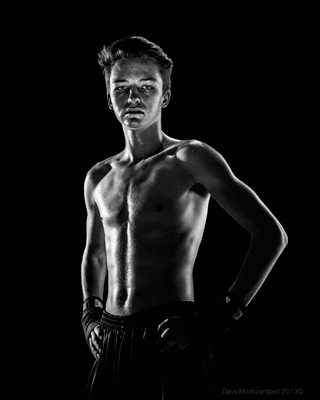articles/Lighting/catchlightsbedtimestory-page2
A Catch Light's Bedtime Story - part 2 of 1 2
by Dave Montizambert Published 01/02/2013

There is one other factor along with the distance of source that controls the brightness of catch lights, and that is physical size - using a smaller light, soft-box, octa-box, umbrella, scrim, etc, greatly aids in keeping the catch light brilliant while maintaining a dark, night-time-lit flesh-tone. As you decrease the size of a light source - let's say switching from a 4x6 foot soft-box to a 2x3 foot soft-box - the reflection of that source imaged on the eye, will now cover only 1/4 of the original area. Since the power of the light has not been adjusted, the same amount of energy is forced to cover less area, 1/4 of the area in this example. This will increase its apparent brightness by four times or by two camera f-stops. In the end the brightness of the subject's flesh stays the same but the catch light is brighter and smaller - same end result as increasing distance of source, only no exposure adjustment required.
Night time Look:
For my night time-look lighting technique used on light weight boxing champion and model/actor Owen Vaags, I used two specular contrast controls: I placed the source further away and I used a relatively small source - a 10"x7" reflector (a silvercard catching light from a strobe head with a 5" parabolic reflector some 6' away) placed down low at 2.5 feet off the floor and positioned 5 feet away from his face. An incident meter reading with the back of the meter against Owen's face and with the dome pointing at the reflector, gave a reading 21⁄3 stops darker than the camera exposure setting. This means that where-ever his face is fully lit by this source, it will be 21⁄3 stops underexposed. Since the source skims its reflected light across Owen, lots of dramatic shadows occur, making his face seem darker. This reflector is a very directional source, which allowed me to spotlight his face without striking the rest of his body. You will notice that Owen's face doesn't look completely underexposed, there are lots of bright shiny bits (specular highlights) over his face and of course there are the two brilliant catch lights in his eyes, all controlled by the size and distance of this silver-card-strobe-head-combination light-source. Another aspect that can really help get this beddie-time look is to use high contrast processing settings or bump the image's contrast up nice and high, after the fact, in Photoshop. Pleasant dreams!
Please Note:
There is more than one page for this Article.
You are currently on page 2 Contact Dave Montizambert
1st Published 01/02/2013
last update 09/12/2022 14:52:20
More Lighting Articles
There are 0 days to get ready for The Society of Photographers Convention and Trade Show at The Novotel London West, Hammersmith ...
which starts on Wednesday 15th January 2025





